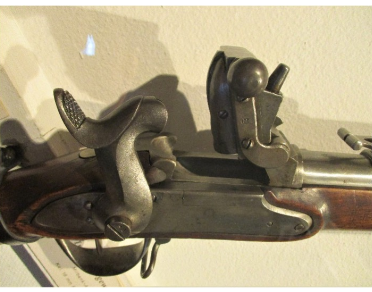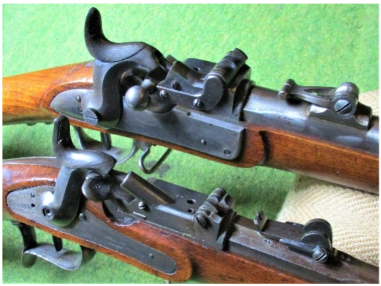Die Handfeuerwaffensammlung im Schützenmuseum umfasst über 400 Objekte. Im Treppenhaus vom EG zum 1. OG wird die Entwicklung der Schweizer Ordonnanzwaffen bis zum heutigen Tag chronologisch dargestellt.
The handgun collection at the Rifle Museum comprises over 400 objects. The staircase leading from the ground floor to the first floor presents a chronological presentation of the development of Swiss service weapons up to the present day.
Excerpt (Translated)
The breech-loading rifles (19-23)
Until the mid-19th century, muzzle-loading rifles dominated the battlefields.
The so-called Dreyse needle gun was invented in 1838 and introduced into the Prussian army in 1842 as the first European breech-loading rifle. Its advantages were reloading while lying down and a higher firing rate of approximately three to five rounds per minute.
In its report to the Federal Assembly on July 12, 1866, nine days after the Battle of Königgrätz during the Austro-Prussian War, where the superiority of breech-loading rifles over muzzle-loading rifles became evident, the Federal Council wrote:
“The technical improvements that breech-loading rifles had recently received and the military experience gained with them in the American and Danish wars prompted the Federal Council to seriously examine the question of introducing breech-loading rifles into our army and to immediately take the necessary preliminary steps to conduct trials.”
Initially, breech-loading models were constructed from existing muzzleloaders. The (19) Infantry Rifle Eidg. Ord. 1817/42/59/67 demonstrates the long history of development of Swiss small arms. Built as a Bernese Ordnance Rifle Model 1817 based on the French Model 1777, it was converted to a percussion rifle in 1842, equipped with a rifled barrel in 1859, and finally converted to a breech-loader using the Milbank-Amsler process in 1867 by the Sulzer brothers of Winterthur. This locking system was a further development of the American Milbank patent by the Schaffhausen professor Jakob Amsler-Laffon (1832–1912).

Large-caliber and small-caliber muzzle-loaders were modified, such as the (18) Federal Ordnance Infantry Rifle 1863, the (20) Swiss Marksman’s Rifle 1851/67, the (21) Swiss Hunter’s Rifle 1853/59/67, and the (22) Swiss Field Rifle 1864/67.
The modifications to the breech-loading system were commissioned from a total of 24 Swiss companies, with the majority of the work being awarded to the Swiss Industrial Company (SIG) in Neuhausen. By the beginning of 1869, approximately 133,000 muzzle-loading rifles had been converted to single-shot breech-loading rifles, leading to a “rifle shortage” in the army. Therefore, on July 12, 1866, the Federal Council decided to purchase approximately 15,000 imported American “Peabody” rifles with falling-block action. This rifle had already been used in the American Civil War. Designated the Peabody System Engineer Rifle, Mod. 1867, and later (23) Peabody Rifle, Federal Order, 1867/77, it was first issued to the snipers and, from 1873, to the engineer troops.
The Model 1867/77 differs from the original by a narrow cartridge ejector – this modification was noted by the stamping of a “U” on the barrel under the sight – and, when the original American barrels were shot out, by a Swiss replacement barrel.

The first breech-loading rifles still used “paper cartridges.” The advantages of such a cartridge were its simplicity and low cost of production. The introduction of the metal cartridge made it gas-tight. One of the first standard cartridges with a metal case was the rimfire cartridge, a type of ammunition in which the primer—mercury fulminate—also served as the propellant.